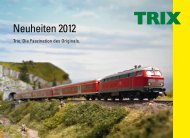Brawa - Micro Macro Mundo
Brawa - Micro Macro Mundo
Brawa - Micro Macro Mundo
Create successful ePaper yourself
Turn your PDF publications into a flip-book with our unique Google optimized e-Paper software.
Covered Freight Car Gm K.W.St.E.<br />
Road no. 29 955<br />
Covered Freight Car “Dresden”<br />
“Miele“ DB<br />
Road no. 192 222<br />
Starting in 1907, the Royal Württemberg State<br />
Railways procured closed goods waggons<br />
which corresponded to their Prussian counterparts<br />
in all essential dimensions. Typical for<br />
Württemberg was the division of the body into<br />
8 segments, with the weakening of a box<br />
column for the sliding door. This was lined<br />
with sheet metal for Württemberg waggons. In<br />
1905 the Royal Württemberg State Railways<br />
adopted the Prussian system of designation,<br />
but the waggons were still painted in independent<br />
fir green. The first vehicles delivered still<br />
had framework-like axle guards, which soon<br />
had to give ground to guards made of pressed<br />
sheet for the following deliveries. All waggons<br />
were built without air brakes and hand brakes.<br />
1,813 waggons were delivered in all.<br />
DELIVERY DATE: 2ND QUARTER 2012<br />
48264<br />
Order no. 48670<br />
Order no.<br />
After the procurement was finished, the Deutsche<br />
Reichsbahn Gesellschaft (DRG) still had<br />
121,770 waggons according to the A2 master<br />
drawing in their inventory in 1934, making it<br />
the most constructed closed goods waggons<br />
in the world. Due to the larger tensile loads,<br />
the use of air brakes and higher speeds, the<br />
underframe was exposed to stresses requiring<br />
reinforcement. The waggon bodies were stabilised<br />
in the Reichsbahn repair depots by<br />
means of additional struts. In addition, the<br />
brakeman‘s cab was reduced by the part standing<br />
above the roof to prevent the permeation<br />
of moisture at this location. The two jobs were<br />
not necessarily carried out at the same time,<br />
so there were waggons in different conversion<br />
combinations.<br />
DELIVERY DATE: 4TH QUARTER 2012<br />
Model: Wheelsets in toe bearing; applied grab rails and steps in low material thickness; close coupling; extra steps; undercarriage<br />
with extra brake system; extra signal holder; many extra parts such as door latches; metal axles with conical bearings; extra door<br />
latches; metal pedestal tie bars; individually affixed U-profiles as front ladder rungs; NEM close-coupling cinematics<br />
Model: extra mounted steps; wheelsets with inside contours; true-to-original replica of the car bottom; extra mounted brake<br />
system and brake-switch; precise printing and lacquering; extra mounted springs and wheel bearing; fine engravings and rivets;<br />
short coupling cinematic<br />
Covered Freight Car G K.P.E.V.<br />
Road no. 600 094<br />
Covered Freight Car Gw (G) DR<br />
Road no. 21 50 112 3056-6<br />
Numerous Verbandsbauart covered freight<br />
cars – in a design standardised by the Deutsche<br />
Staatsbahn-wagen-Verband (German<br />
Railway Wagon Association) – came to the<br />
Deutsche Reichsbahn in the Soviet zone. There,<br />
too, they were a supporting pillar of<br />
freight train services for many years.<br />
DELIVERY DATE: 2ND QUARTER 2012<br />
48260<br />
Order no.<br />
48266<br />
Order no.<br />
From 1916 onwards, the Berlin Central Railway<br />
Office and the Central Purchasing Company<br />
bought refrigerator waggons in large<br />
quantities. The basis for the procurement was<br />
the covered goods waggon according to the<br />
A2 master drawing. From the outside, they<br />
were only recognizable as refrigerator waggons<br />
by the second ventilating shutter, the<br />
roof ventilators, and a white coat of paint to<br />
protect against sunlight. The waggons were<br />
leased to various war societies and Reich<br />
agencies, so their waggon number was not<br />
followed by a P. They were used for the transport<br />
of frozen meat and butter, since more<br />
and more frozen meat had to be sent instead<br />
of live animals for slaughter.<br />
DELIVERY DATE: 2ND QUARTER 2012<br />
Model: Wheelsets in toe bearing; applied grab rails and steps in low material thickness; close coupling; extra steps; undercarriage<br />
with extra brake system; extra signal holder; many extra parts such as door latches; metal axles with conical bearings; extra door<br />
latches; metal pedestal tie bars; individually affixed U-profiles as front ladder rungs; NEM close-coupling cinematics<br />
Model: Wheelsets in toe bearing; applied grab rails and steps in low material thickness; close coupling; extra steps; undercarriage<br />
with extra brake system; extra signal holder; many extra parts such as door latches; metal axles with conical bearings; extra door<br />
latches; metal pedestal tie bars; individually affixed U-profiles as front ladder rungs; NEM close-coupling cinematics<br />
Covered Freight Car G 10<br />
“Persil“ DR<br />
Road no. 535 333 P<br />
1 2 3<br />
1_Extra mounted steps<br />
2_Finest paintwork and printing<br />
3_Fine engravings and rivets<br />
(Pictures show order no. 48259)<br />
48259<br />
Order no.<br />
At the beginning of the 20th century,<br />
chemists of the Henkel group developed a<br />
new automatic washing powder which came<br />
onto the market under the name „Persil“. In<br />
1922, the Berlin artist Kurt Heiligenstaedt<br />
created the famous „white lady“, who from<br />
then on dominated the Persil advertising. To<br />
transport raw materials between the factories<br />
and Düsseldorf, tank cars but also<br />
covered freight cars were used. Therefore to<br />
increase familiarity, some G-cars of the federation<br />
construction type were also painted<br />
green and advertised clean washing with the<br />
logo of ”Persil“.<br />
DELIVERY DATE: 2ND QUARTER 2012<br />
Model: Wheelsets in toe bearing; applied grab rails and steps in low material thickness; close coupling; extra steps; undercarriage<br />
with extra brake system; extra signal holder; many extra parts such as door latches; metal axles with conical bearings; extra door<br />
latches; metal pedestal tie bars; individually affixed U-profiles as front ladder rungs; NEM close-coupling cinematics<br />
64 FREIGHT CARS<br />
65



